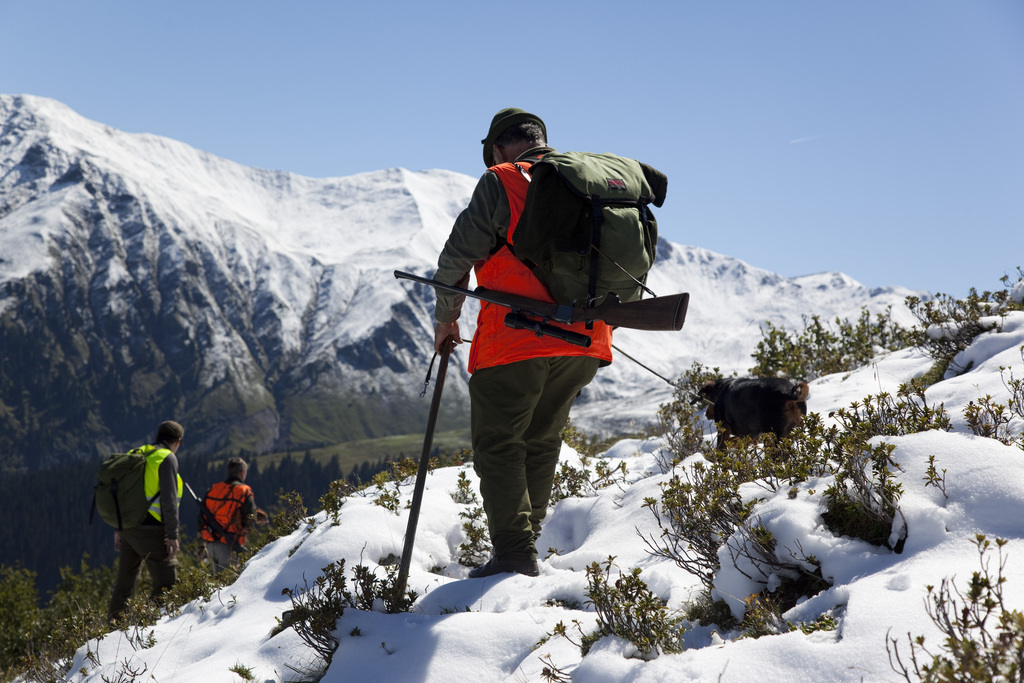Finding meaning in the hunt

Folklore and literature seek to plumb the mystery of the hunter’s encounter with his prey. This is particularly true in the Swiss canton of Graubünden, with its isolated peaks and valleys where hunters roam free.
“Hunter and hunted form a circle,” says Herbert Schönhart, who has hunted in Graubünden among other places, and who finds the sport a profound experience.
“You are hunting, but you could be hunted. You are face to face with death. Hunting means getting in touch with your own transience.”
It is also metaphor for so many things in life, he finds, whether it be love, the pursuit of success, or something else ardently desired. “Man is a hunter by nature – even if he doesn’t admit it.”
There is a belief too that the right animal will “reveal” itself to a hunter. This animal is somehow meant for you, and the shot goes home just as it should. There are hunters who do not shoot anything for years at a stretch because no animal “reveals” itself to them, Schönart tells swissinfo.ch.
He mentions the many eerie legends among hunters about particular animals that have a charmed life and can’t be shot. When hunters try to shoot them, they unaccountably miss, or the rifle jams.
Like many philosophical hunters, Schönhart refers to José Ortega y Gasset’s classic treatment “Meditations on hunting”.
The contemporary Spanish philosopher writes that “the essence of recreational hunting is not raising the animal to the level of man, but something much more spiritual than that: a conscious and almost religious humbling of man which limits his superiority and lowers him toward the animal”.
Ortega y Gasset does take a rather aristocratic approach, insisting that hunting is a noble pursuit if it is for sport, not if it is for subsistence. Yet subsistence is what has made most people hunt over the centuries.
Tall tales
Hunting is rooted in Graubünden, and in the tradition of the canton’s Romansh people. Clau Solèr, professor of Romansh at Geneva University, tells swissinfo.ch “the hunt is very present just about everywhere” on the Romansh scene.
Solèr evokes folktales about the hunt, which often involve eerie encounters with the supernatural, particularly what he calls the “woman/fox” motif.
This recurrent theme concerns a hunter encountering a fox or other game animal who turns out to be a woman, in fact, a witch. It was believed that witches went to their covens in the guise of some animal such as a fox.
In one story, the hunter shoots the animal, which is wounded but gets away. On returning to the village, he finds that a woman there has been taken ill with the very same injury. She is a witch. In one version it is his own grandmother, who curses him from her sickbed before dying.
In another widespread story the hunter encounters a fox tied to a tree. Instead of shooting it, he is moved with compassion and sets it free. It turns into a woman, or later reveals itself as a woman. She was a witch, who had been punished by her coven for some transgression.
On the other hand, there are stories of miraculous hunters whose success is due to them having a pact with the Devil. And in one story from German-speaking Graubünden, a high-ranging hunter is warned by the spirit of the mountain not to hunt his chamois herds. In compensation, he gets a chamois delivered regularly to him. However, the hunter is greedy and cannot resist going back up the mountain to hunt. The angry spirit hurls him over a precipice to his death.
There are also many evocations of hunting in Romansh literature, says Solèr, at first in the Engadine, but more recently in the Surselva region with the writer Leo Tuor.
Debunking the myth
Tuor has written a lot about hunting, including the successful novel “Settembrini”. Asked if he was going hunting as usual, the writer and part-time herdsman told swissinfo.ch: “I’ll hardly have time to hunt this year, seeing as our Alp will be ‘unloading’ in the middle of September.” The herds of animals have to be brought from the Alpine pasture down into the valley, which is itself a tradition.
Tuor talks about the special place the hunt has in the hearts of locals, and the fierce pride that is associated with it.
“Since 1526 the Graubünden hunt has been a right of the people, probably unique in Europe. Hunting has meant freedom with us for just about 500 years. Graubünden folk are proud of that privilege and of being able to go around the countryside with a rifle.”
“I use mythology and tradition as material for my writing about the hunt,” Tuor says. But he tends to debunk any aristocratic pretensions about hunting. This goes with his insistence on the democratic nature of the hunt in Graubünden.
“Real Graubünden folk went hunting so they could have meat to eat, not for sport” he says. “Hunting was something pragmatic. There was no tradition of hunting as such – special vocabulary, special outfits, blowers of horns…”
He dismisses it as “all really just embarrassing imported folklore”.
Peter Egloff, who translated Leo Tuor’s novel into German and is himself a hunter in Surselva, sees little in the way of that kind of grand hunting tradition either.
“At most you could say that Graubünden, due to its large area and the large number of hunters, is a special case in Switzerland” he tells swissinfo.ch.
“About 20 per cent of Swiss hunters are hunters from Graubünden. Even this is a fairly recent development – by the second half of the 19th century game stocks were almost extinct, except for a few chamois and marmots. Despite this, early tourists [such as the English] liked to think of hunting in Graubünden and in the Alps as something exotic.”
In Roman law, game was “res nullius”, no man’s property. For the first time in the Middle Ages, hunting, at least hunting larger game, was monopolised by the aristocracy. In 1050, for example, the Bishop of the eastern Swiss city Chur, a feudal prince in his own right, was awarded exclusive hunting privileges on a large swathe of what is now north Graubünden by the Holy Roman Emperor Henry III. It seems the sporting bishops were particularly keen on falconry.
The revolutionary Articles of Ilanz in 1526, which put an end to the old feudal order in Graubünden, awarded the privilege of hunting to all the people. The communes now ran their own game preserves and only locals could hunt there.
This free-for-all was disastrous for game stocks. The ibex, Graubünden’s heraldic animal and tourist mascot, was hunted to extinction by the 17th century and had to be reintroduced later. The wolf and the bear were gone by the early 19th century, and have only staged a comeback in the past few years.
Meanwhile, in 1805, the new canton Graubünden abolished the communes’ privilege and introduced open hunting for all. For the first time, too, a hunting season was specified.
The first federal law on hunting (1875) was followed by a cantonal one (1876). In 1878 the Graubünden people voted to have licensing with an affordable fee. The cantonal act was last revised and approved in 2006, taking account of advances in the science of wildlife management.
(Source: Lexicon Istoric Retic)

In compliance with the JTI standards
More: SWI swissinfo.ch certified by the Journalism Trust Initiative










You can find an overview of ongoing debates with our journalists here . Please join us!
If you want to start a conversation about a topic raised in this article or want to report factual errors, email us at english@swissinfo.ch.